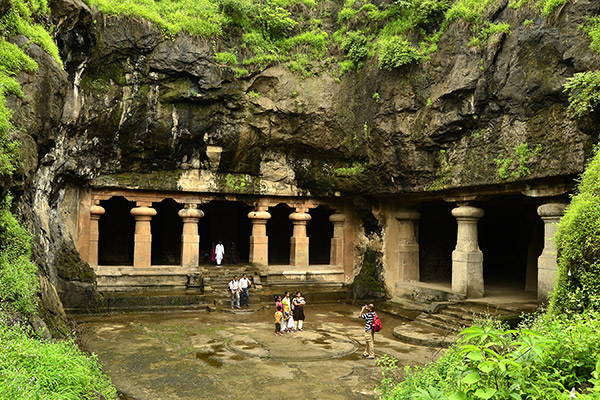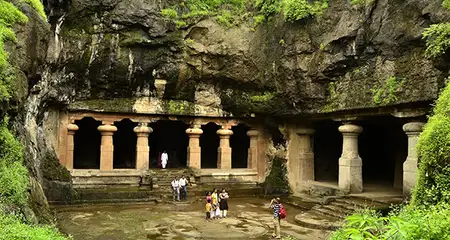The first impression I had of Mumbai on my maiden visit to the city was that it is unlike any other metropolitan in India. Today, even after multiple visits, that impression remains intact. If you visit it like a tourist, the city will fascinate you with its glitz and glamor. But, when you explore it beyond its known façade, the City of Dreams unveils a very different aspect. You might find it hard to associate Mumbai – the city of the perpetual rush and latest trends – with anything from bygone eras. And yet, Mumbai relives the mysticism of the past through one of its most visited attractions, the Elephanta Caves. Since I have always been fascinated by historic edifices and monuments, these caves were on my bucket list for some time now.
So, on my recent visit to the city, I decided to take a trip to this famous UNESCO World Heritage Site. Let me tell you, exploring the majestic the Elephanta Caves has been one of my most memorable experiences in Mumbai. It catered to the history buff in me, taught me a lesson or two about ancient cultures, and offered me nothing less than an absolute visual treat in terms of scenic and architectural beauty. Here is a detailed account of my day-long visit to the mesmerizing Elephanta Caves in Mumbai.
Reaching the Elephanta Caves through the Waterway
My trip to Elephanta Caves began on a bright sunny morning after an overnight stay at a budget hotel in Mumbai. Excited as I was, I got ready in a jiffy and ventured out after a quick breakfast at the hotel.
I had done a bit of research beforehand, regarding how to reach Elephanta Caves, and knew that the Gateway of India was my gateway to Elephanta Island, my destination for the day. Located about 10 km into the Mumbai Harbor, Elephanta Island houses the historic Elephanta Caves. In order to reach the island, a ferry service by the Maharashtra Tourism Development Corporation (MTDC) is available from Apollo Bunder near the Gateway of India.
I knew from the homework I did that the ferry service departs Apollo Bunder at 09:00 am. But, since I didn’t opt for Elephanta Caves ferry online booking, I reached the MTDC ticket booth near the Gateway of India early to ensure a seat on the first ferry leaving for the island. The ferry service is available in two categories, namely Deluxe and Economy. I went for an economy ticket, which is, needless to say, cheaper than a deluxe ferry service ticket. After a few minutes, I was on an hour-long journey to reach the well-known heritage caves of Mumbai.
Elephanta Caves: A Saga Etched in Stone
Upon reaching the island, I felt as if I had been transported to a different place in a different time period. The forested, hilly island was nothing like the busy metropolis I had left behind, just 10 km away. Yet, it exuded a unique charm of its own. And in that charming ambiance, atop a hillock, stood the magnificent Elephanta Caves! A long flight of 120 steep stone steps leads the way to these caves. Though a toy train is there to carry tourists from the dock to the caves entrance, I preferred to walk my way up the hillock.
This UNESCO World Heritage Site is a wonderful example of history, heritage, and craftsmanship rolled into one. The site has a group of cave temples dedicated to the Hindu deity, Lord Shiva, and also a couple of Buddhist caves. All these caves (five Hindu and two Buddhist) together are known as the Elephanta Caves. Various rock-cut sculptures adorn the interiors of these caves.
I may not be an expert on the architectural style of historical edifices, but the rock-cut architectural style of these caves presented a splendid sight. The Elephanta Cave temples are carved out of solid basalt rock and these stand as a strong testimony to a long-lost civilization. Mindless destruction and centuries of neglect may have robbed much of the grandeur that these caves once boasted, but these are still worth your time and are an enigma in themselves. There’s no denying that the Elephanta Caves are a one-of-its-kind monument.
Also check hotels in Mumbai for Couple
History of the Elephanta Caves
While it is a known fact that the island as well and the caves were named Elephanta by the Portuguese invaders, not much else is documented about Elephanta Caves’ early history. The discovery of elephant sculptures in black stone on the island led the Portuguese invaders to bestow the name on the island.
No one knows for sure when these caves came into being or who their creators were. But, most historians believe that they were built between the late 5th century and late 8th century. The earliest records pertaining to the island identify it as Puri or Purika, which was the capital of the Konkan branch of the Maura dynasty during the 6th century. But there is no clear evidence of the role of the Maurya rulers in establishing these caves.
Exploring the Elephanta Caves
As I proceeded to explore the caves at a leisurely pace, a few guides accosted me and offered their service, which I politely declined. If you are aware of Lord Shiva and his stories, you actually do not need a guide to go around this place. And, I have done enough homework on navigating this place. However, if you want a little assistance on the history of this place and want someone to explain the stories depicted on the sculptures, you can indeed take help from these local guides.
Being on my own, I started my exploration from the main cave on Cannon Hill, which is also called Cave 1 or the Grand Cave. The highlight of this cave is a colossal, three-faced sculpture of Lord Shiva, named Sadashiva. It is believed that the three faces represent three significant aspects of Shiva’s personality, namely creation, protection, and destruction. Apart from Sadashiva, seven other manifestations of Lord Shiva are also represented in the main cave, such as Nataraja, Andhakasuravadha, Kalyanasundaramurti, Yogishvara, Ardhanarishwara, Ravanaanugrahamurti, and Gangadharamurti. Each of these representations is enticing in its own way.
Sadly, I found that the rest of the caves weren’t in great shape. Since Cave 2 was restored a couple of decades ago, some of its previous glory can still be witnessed. But the same can’t be said of Caves 3 to 5; however, the artwork in these caves suggests that these were once Shiva shrines.
Cave 6 and 7 are located on Stupa Hill. I found myself in a huge hall called Sitabai’s temple cave. There was no image of any deity in the sanctum of the shrine here. These two caves also bear traces of monuments lost to the merciless dictates of time and human invasions. You will see that many sculptures on the island are defaced, and this is because centuries ago, Portuguese soldiers used these for their target practice! Despite the destruction, and damaged structures and caves, I found Elephanta Caves to be an incredible combination of sculptural art and aesthetic beauty.
By the time I finished exploring Cave 7, I was tired. Now, that’s not surprising given that the caves cover an area of 60000 sq. ft. Also, it was time to wrap up my tour and make my way back to Mumbai. As per Elephanta Caves ferry timings, the last ferry for the return journey leaves the island at 5:30 pm and it was about time I made a move.
Also Read: Places to Visit in Maharashtra
The Return Journey
While coming down the hill, I stopped at a few of the small shops inundating the sides of the stone steps. These sold a lot of artifacts, religious images, handmade jewelry, food, and drinks. I even picked up a few statues and other knickknacks as memorabilia of my trip to the island as well as some souvenirs as gifts for my family and friends. Finally, after a really long and fulfilling day, I was seated on the ferry that was to carry me back to the hustle and bustle of Mumbai. Since no tourist is allowed to stay overnight on the island, everyone made a rush for the last ferry, and hence it was quite crowded.
Travel Tips for Visitors
If you are planning a visit to this beautiful site, you must remember a few points. Here are my two cents:
- The best time to visit Elephanta Caves is during the morning hours when the crowd is yet to swell up. In that way, taking the first jetty ride to the island proves helpful.
- The island is full of monkeys, and if you are not careful enough, they may try to snatch your packet of food and run away with it.
- Wear comfortable shoes, preferably, a pair of walking shoes or sneakers, and carry water with you to keep yourself hydrated.
- You can taste the local berries that are sold on the island as they are delicious.
- If you are hungry, you can get food and drinks here at a reasonable rate.
Elephanta Caves Entry Fees
Indians – ₹ 10
Citizens of Afghanistan, Bhutan, Nepal, Maldives, Bangladesh, Sri Lanka, Myanmar, Pakistan, and Thailand – ₹ 10
Citizens of other foreign countries – ₹ 250
Toy Train Ride – ₹ 10
Timings
9:00 am to 5:30 pm; closed on Mondays
Elephanta Caves Ferry Timings and Fees
The ferry service to the Elephanta Caves starts at 9:00 am, and the last ferry leaves for the island at 3:00 pm. There is a ferry at a frequency of 10 minutes. The first return ferry from the island is at 12:00 pm and the last at 5:30 pm.
Ferry Ticket Cost:
Adults – ₹ 150
Children (between 3 to 7 years of age) – ₹ 125 per person
Elephanta Caves are not just a great escapade from your busy life, but also a wonderful trip to a forgotten era of art and architecture that still speaks volume of how diverse our culture is. So, next time you visit the city of Mumbai, keep a day aside to take a trip to this wonderful heritage site. You will not be disappointed, I promise!




























